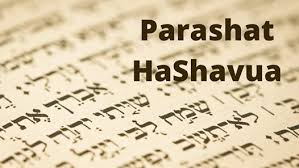Bonjour / Hello [nickname_else_first_name],
Table of contents
1) Perashat Hashavoua - Rabbi Eli Mansour
2) Halakhat Hashavoua - Chazzan David Azerad -
Shabbat Hachodesh and Halacha for Pesach
3) Holy Jokes!
4) FOR KIDS!

This Week's Parasha Insight with Rabbi Eli Mansour
Parashat Shemini: The Lesson of the Para Aduma
The section of Parashat Para, which speaks about the Para Aduma ("red heifer"), is read before Rosh Hodesh Nissan, because in the times of the Bet Ha’mikdash, the people would need to purify themselves in preparation for the Pesach sacrifice. The special water made with the ashes of the Para Aduma was used to purify people and objects that had become Tameh (impure) as a result of contact with a human corpse.
The Sages teach that the command of the Para Aduma was issued nearly a year after the Exodus from Egypt, at the beginning of the month of Nissan, at the time of the inauguration of the Mishkan. It was only at that point when these laws became relevant, as people in a state of Tum’a (impurity) were barred from entering the Mishkan and from partaking of the sacrifices offered there.
Interestingly, however, Beneh Yisrael actually learned about the Para Aduma earlier. As Rashi comments in Parashat Beshalah (Shemot 15:25), when Beneh Yisrael encamped in a place called Mara after crossing through the sea, G-d gave them a number of Misvot – one of them being the Misva of Para Aduma. Although this Misva would not become practically relevant until nearly a year later, nevertheless, they were taught this Misva already then.
The question naturally arises as to why this Misva was deemed significant enough to be one of the Misvot taught in Mara. The other Misvot, Rashi writes, were fundamental Torah precepts – Shabbat observance, and Dinim (the establishment of a just court system). But why was it important for Beneh Yisrael to learn about the Para Aduma already at that point, in Mara?
Rav Yaakov Kamenetsky (1891-1986) explained that Para Aduma constitutes the quintessential "Hok" – Misva whose rationale eludes human comprehension. The Torah commands taking a cow with very specific properties – it’s completely red, without physical defects, and has never been used for any work – and to burn it and mix its ashes with natural spring water. This water will then bring purity to people and articles that had become impure. There is no possibility of explaining the rationale for this concept. The Sages teach that even King Shlomo, the wisest of all men, conceded that he could not understand the reason behind this Misva.
This is why it was so important for Beneh Yisrael to learn this Misva at a very early stage, even before Matan Torah. As part of their preparation for Matan Torah, they needed to be shown that all Misvot – even those which appear to have a compelling rationale, and which we thus think we understand – must be observed out of a sense of submission and subservience to G-d, and not because we understand what they are intended to accomplish. Para Aduma, the quintessential "Hok," shows us how to approach all Misvot – as G-d’s commands which we humbly obey, regardless of whether or not we understand why He commanded them.
The anonymous Sefer Ha’hinuch is a work which lists all 613 Misvot (according to the Rambam’s counting), and suggests reasons for each one. The author writes openly that he presents these reasons only to help us better appreciate the Misva’s value, without claiming that they fully encapsulate the reasons behind Misvot. The Hebrew word for "reason," he notes, is "Ta’am," which also means "flavor." Uncovering reasons for Misvot enhances their "flavor," making their performance more meaningful. But just as a food product can be eaten and offers nutritional value even without seasoning, similarly, the Misvot are valuable and vitally important even if we do not understand their reasoning.
The Sages teach that Abraham Abinu ate Masa on Pesach. Quite obviously, he lived well before the Exodus from Egypt, which the Misva of Masa commemorates. The Brisker Rav (Rav Yitzhak Zev Soloveitchik, 1886-1959) noted that this shows that eating Masa on Pesach is intrinsically valuable simply because G-d commanded us to do so. Commemorating Yesiat Misrayim is but the "Ta’am," an additional element to the Misva, but the essence of the Misva of Masa is our humble subservience to the divine will.
This is the message of the Para Aduma – that we observe all of the Torah’s Misvot out of a sense of submission to Hashem’s authority, irrespective of whether or not we understand their reason.

Shabbat Hachodesh and Halacha for Pesach
This Shabbat is the fourth of four supplementary readings added in the weeks preceding Purim and Passover (Shekalim, Zachor, Parah and Hachodesh)
.
Parashat Hachodesh is the Shabbat that falls on OR before the first of Nissan, we also read the section of Hachodesh, which relates Hashem’s words to Moshe Rabeinu in Egypt two weeks before Yetziat Mitzrayim (exodus), instructing us to set the Jewish Calendar by the monthly new moon, and to regard Nissan as the “head of months.” G‑d also instructs to bring the Passover offering, to eat it with Matzah and Maror (bitter herbs), and to abstain from Chametz (leaven) for seven days.
Vessels for Pesach
On Pesach, one must use vessels and dishes that have not absorbed Chametz, meaning either new vessels (or vessels designated specially for Pesach use) or vessels that have been koshered for Pesach. Usually, the way to kosher a vessel is in the same manner it is normally used.
Regarding plates and bowls made of metal or plastic that hot foods are placed in but are not used as an actual “Keli Rishon” (i.e. a vessel with boiling hot liquid directly on the fire or heat source), meaning that when food is placed in them, it is usually dished out of another pot (and this pot was the “Keli Rishon” where the water was actually boiled), their koshering process is in the way it is used, i.e. through pouring boiling water on them from a “Keli Rishon” (for instance, from an electric kettle that water was boiled in). Certainly, these items may be koshered through “Hag’ala,” meaning immersing them into boiling water in a “Keli Rishon” where the water was boiled.
Regarding pans that are used to fry Chametz foods in oil, there is a disagreement among the Poskim whether it can be halachically considered like a pot that Chametz foods are cooked in and Hag’ala will be sufficient or since not much liquid is used to fry foods in it, it should have the halachic status of skewers which require “Libun,” torching with fire. The custom of Sephardic Jewry is that Hag’ala is sufficient for frying pans, while the Ashkenazim customarily require Libun with fire for these pans. Maran Rabbeinu Ovadia Yosef zt”l writes that even according to the Ashkenazi custom, it is not necessary to fire up the pan to such a degree that it turns red-hot; rather, a light Libun, i.e. that it becomes hot enough from the fire that if a straw would come in contact with the pan it would burn, is sufficient.
Any vessels not used with hot foods or liquids, such as silver goblets, refrigerators, and freezers, do not require any koshering and a thorough cleaning is sufficient.
Glass vessels do not require any koshering and according to Maran Ha’Shulchan Aruch, a thorough washing is sufficient for them. The Ashkenazi custom, however, is to act stringently in this regard. We have already discussed this regarding the laws of milk and meat.
There are some Sephardic communities outside of Israel who had the custom to abstain from using glass used throughout the year on Pesach. Nevertheless, Maran Rabbeinu Ovadia Yosef zt”l rules that when these communities emigrate to Israel, they may immediately nullify their customs and observe all rulings and customs based on Maran Ha’Shulchan Aruch. Indeed, even acting stringently against the ruling of Maran in Israel is inappropriate, for this can be construed as belittling the honor of Maran Ha’Shulchan Aruch who was the chief authority and master of the Land of Israel.
Vessels made of pottery (ceramic, clay, china, porcelain, etc.) are unable to be koshered; even if they were to be torched with fire very well, they would remain in their forbidden state.
It is preferable, whenever possible, to perform Hag’ala on vessels needing koshering only after they have not been used for twenty-four hours. It is permissible to perform Hag’ala on meat and dairy vessels one after another when the Hag’ala is being done in a large pot.
Shabbat Shalom Umevorach
David Azerad
3) HOLY JoKeS!!
Selection of funny snippets, loosely related to this weeks parashah or current events, to brighten your day
A poor man finds God while walking through a forest.
“God, what is a million years like for you?”
“My son, for me a million years is like a second.”
“God, what is a million dollars to you?”
“My son, a million dollars means nothing to me.”
“So God, can I have a million dollars?”
“In a second.”
4) FOR KIDS
Click on the image to open the youtube video














